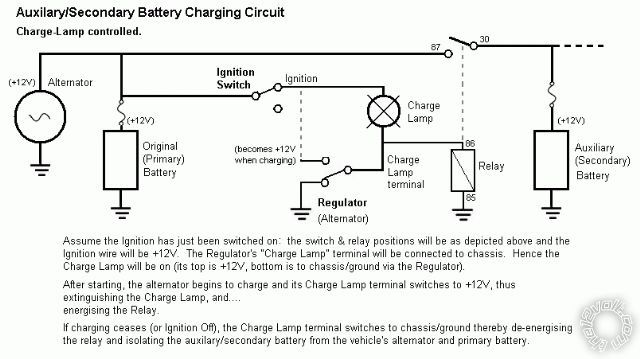Solenoid, relay - same thing. (Ambiguities - a solenoid is a coil as in the actuating coil of a relay. But a BIG relay is often called a solenoid.)
I bet your Nissan has a charge lamp wire - aka "D+" or "L" from the alternator. Or don't you have a charge lamp?
In single-wire alternators (ie, heavy B or B+ cable to battery +12V that all alternators have, plus a single other wire), the charge-Lamp "L" is called D+.
In 2- & 3-wire alternators, it is called L.
That goes to the dash's charge lamp as shown in the diagram.
It might instead go to a relay that controls charge and other lamps, but not on older vehicles.
That L/D+ circuit may also be diode-connected to other lamps that are tested upon IGN-on (eg, brake warning light). On older cars, these tested lamps also comes on whenever the alternators stops charging (and the ignition is on - eg, charge failure or engine stall).
The above diagram depicts a typical charge-sense relay (solenoid) system except that the after-market "smart" relays/solenoids use a voltage sensor to control the relay (#86) - eg, relay on if the main battery/alternator exceeds (say) 13.5 Volts (and off if below 13.0, and maybe if above 14.5 etc).
I had a system like that - a sensor with settable voltage and hysteresis delays - that would control the relay (in its case, a latching 80A relay).
But when it failed, I hit on the above idea.... (Alternators don't need water proofing against high-pressure engine cleaners.)
It's not quite the same as the voltage sensing method.
Instead, it connects the 2nd battery whilst its alternator thinks that it is charging.... ie, its charge lamp is off.
It is the same system that is used for many electric fuel pump relays where the fuel pump "
shall be off if the engine is NOT running".
[ FYI: Hence if you have that fuel pump, consider connecting your relay's #86 to the fuel-pump relay's output so as to not add extra load to the (alternator) voltage-regulators L/D+ output - but other considerations include if the fuel pump is on during cranking or is ECU controlled (in which case it is better to have the new aux-battery relay supply the L/D+ signal to vehicle - ie, intercept the L/D+ with your #86 and relay, and feed its output (#87) to the battery and the original L/D+ wire; with a reverse-biased spike-protection diode across the original L/D+ wire). ]
It's a bit like saying that instead of the aftermarket voltage sensors turning on their relays when they
think the car is charging, the alternator turns on the relay when it thinks it's charging.
Nice, simple, and it merely costs a relay - which you should have anyhow (unless you intend to parallel batteries
full-time - but even someone that purports to be Jim McIlvaine, eCare Manager, OPTIMA Batteries, Inc. hasn't come back to me with evidence to support his statment that it is okay to do so on matched Optimas - I recommend avoiding it....).
Plus the all-important fuses at each end (which you MUST have anyhow!) - though I use circuit breakers (until I have some sort of blown-fuse alarm system!).
It's only if you have a huge solenoid that you might need a extra relay. (Yes: pun - or ambiguity - intended...)
IE - if a big relay (or solenoid) has a big-current solenoid (actuating coil) that might damage the regulator's charge-lamp circuit, then use a smaller relay to turn on the big relay.
I know that most alternators (Bosch, N-Denso, Hitachi (= Mitsubishi, Nissan etc)) can handle 60-Ohm solenoids - ie, about 200mA.
They can certainly sink (ground) higher currents (1 Amp and higher), but supplying +12V current may be limited to less.....
And a caution - jusy about every alternator (regulator) with a charge-lamp circuit needs the charge lamp (or other lamp or resistance) to reliably initiate charging.
Whether they continue charging if that +12V "trickle" or "tickle" current source (via the charge lamp or other resistance) is removed depends on the alternator/regulator.
And many alternators may initiate charging without a charge lamp, but that's not guaranteed (residual or remnant rotor magnetism refers).
And some systems (like the Bosch 2-wire S & L alternators) must have an L connected else their regulator will not function.
(I mention the this as a general caution, and also because I have seen so much incorrect information on the web etc.)
BTW - your "
I assumed that once it was shut off, it would cut the 2 batteries in two, and then the main battery would then receive a full charge is half correct....
When off, the batteries are isolated.
But your main battery will NOT receive full charge because the system isn't charging.
 Printable version
Printable version












 My bad! My apologies. Upon review, I seem VICIOUS!
My bad! My apologies. Upon review, I seem VICIOUS!




